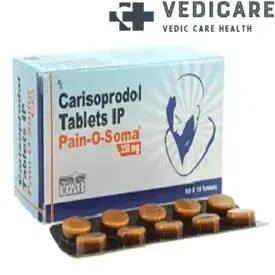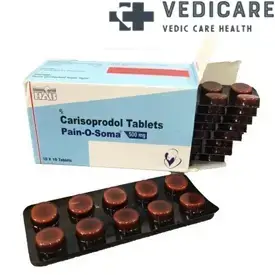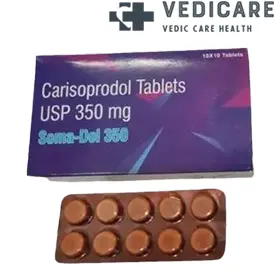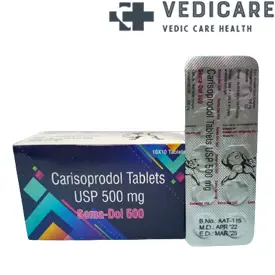
Skeletal muscle relaxants are a class of medication that is used to relax and reduce muscle tension, stiffness, and pain caused by various musculoskeletal conditions. They are classified into two types – antispasmodics and antispastics.
Some of the notable examples of antispasmodics are diazepam, and cyclobenzaprine, while some examples of antispastics are dantrolene and baclofen.
Different types of musculoskeletal conditions can cause skeletal muscles to contract resulting in cramping, tense muscles, or muscle spasms.
Depending on the severity of your condition, you may need to take medicines like skeletal muscle relaxants to treat musculoskeletal pain caused by a sprain, strain, or muscle injury that is beyond at-home treatments.
Consider this blog your roadmap to the best skeletal muscle relaxants available on the market.
What Are Skeletal Muscle Relaxants?
Skeletal muscle relaxants are medications that are used to reduce and relax muscle tension, pain, and stiffness caused by various musculoskeletal conditions such as sprain, strain, spasticity, or muscle injury. In simple terms, they are referred to as muscle relaxants [1].
There are different types of skeletal muscle relaxers, and they work in different ways.
Types Of Skeletal Muscle Relaxants
Skeletal muscle relaxants are divided into two types: antispasmodics and antispastics [2]. Both antispasmodics and antispastics are prescription-based muscle relaxers.
Antispasmodics skeletal muscle relaxants – Antispasmodics are a skeletal muscle relaxer class used to treat muscle spasms ( tightening or painful contractions of muscles).
Antispastics – Antispactics are a group of muscle relaxants that are used to treat muscle spasticity (stiff or rigid muscles).
Skeletal Muscle Relaxants: Uses
Although antispasmodics and antispastics are both types of muscle relaxants, they have different uses.
As mentioned earlier, antispastic muscle relaxers treat spasticity. Spasticity may occur due to different conditions, some of which include –
- Stroke (disruption of blood flow into the brain).
- Head or brain injury
- Spinal cord injury
- Cerebral palsy (group of conditions affecting an individual’s ability to move, maintain balance, and posture).
- Multiple sclerosis (a disorder damaging the insulating covers of nerve cells in the spinal cord and brain).
- Amyotrophic lateral sclerosis (a neurodegenerative disease characterized by degeneration and eventual death of nerve cells of the spinal cord and brain).
Healthcare providers prescribe antispasmodic muscle relaxants for musculoskeletal pain, especially muscle spasms and lower back pain.
Skeletal Muscle Relaxants – Mechanism Of Action
Both antispasmodics and antispastics work differently. Antispasmodics are centrally acting muscle relaxants that work by preventing the nerves from sending pain signals to the brain leading to relief from pain sensations. These types of muscle relaxers are approved for 2 to 3 weeks of use.
Whereas, antispastics work directly on the spinal cord or skeletal muscles with the aim of improving muscle spasms and muscle tightness. These types of skeletal muscle relaxers are used for a short duration, but sometimes they are prescribed for a longer duration based on the severity of the condition.
List Of Skeletal Muscle Relaxants
Antispasmodics
Carisoprodol:
Carisoprodol is indicated to relieve discomfort associated with painful musculoskeletal conditions. The use of Carisoprodol is approved by the Food and Drug Administration.
The standard recommended dosage of Carisoprodol is 350 mg taken by mouth with a plain glass of water. This muscle relaxant is administered once before bedtime and three times during the day ( along with proper rest and physical therapy).
Carisoprodol is sold under various brand names, such as Soma, Rela, Vanadom, and others. All these brands differ in their prices.
One of the most popular and sought-after brands of carisoprodol is Soma. Soma is the most preferred brand version of carisoprodol due to its availability and affordability.
Soma pills are available in different dosage strengths such as 350 mg, and 500 mg.
Soma 350 mg is the starting dose of this muscle relaxant. If you’re curious or interested in this product find more details on the Soma 350 mg product page.
However, if this dose is not effective for an individual, then doctors usually prescribe a larger dose of this muscle relaxant. To explore the highest dose of this brand version of Soma, explore our Soma 500 mg product page.
Cyclobenzaprine:
Cyclobenzaprine is a muscle relaxant used to treat muscle spasms that occur with muscle conditions. Amrix, Fexmid, and Flexeril are some of the most popular brand names for this muscle relaxant.
Diazepam:
Diazepam is another skeletal muscle relaxant that is prescribed for severe muscle spasms. Valium and Diastat are two of the most commonly prescribed brands of diazepam. They are available as tablets or injections.
Antispastics
Baclofen:
Baclofen is approved by the Food and Drug Administration for treating spasticity in people with clonus, flexor spasms, spinal cord lesions, and multiple sclerosis. One of the popular brands of Baclofen is Lioresal.
Dantrolene:
Dantrolene is used to manage muscle spasticity. Some of the brand names for this drug are Revonto, Ryanodex, and Dantrium.
There are also over-the-counter muscle relaxers available on the market that do not require a prescription. One of the most common OTC skeletal muscle relaxants example is Methocarbamol. However, these medications may also carry risks similar to those of prescription muscle relaxers.
Therefore, it is always best to take prescription-based skeletal muscle relaxers with the proper consultation with a doctor.
Natural Skeletal Muscle Relaxants
There are numerous natural ways to relax muscles. These include eating blueberries, cherries, and curcumin, which possess anti-inflammatory properties [3].
Blueberries
Blueberries are an excellent source of polyphenols and antioxidants, which have anti-inflammatory properties.
A study found that consuming blueberries may decrease inflammatory markers and improve exercise performance [4].
Curcumin
Curcumin is present in turmeric, ginger, and cinnamon and has anti-inflammatory properties. Taking supplements of curcumin or adding turmeric, ginger, and cinnamon to your diet can help relax the muscles.
Skeletal Muscle Relaxants – Side Effects
| Antispasmodics | |
| Name of the drug | Side effects |
| Carisoprodol | Dizziness, drowsiness, and headache. |
| Cyclobenzaprine | Dizziness, dry mouth, drowsiness, headache, irritability, and confusion. |
| Diazepam | Drowsiness, fatigue, loss of muscle movement, and muscle weakness. |
| Antispastics | |
| Baclofen | Vertigo, nausea, drowsiness, confusion, and muscle weakness. |
| Dantrolene | Constipation, diarrhea, dizziness, nausea and vomiting. |
This is not a complete table of all the possible side effects of skeletal muscle relaxants. In the event of any unusual side effects seek medical help.
Final Thoughts
Muscle pain can have a number of potential underlying conditions. Muscle relaxers are excellent options that help relieve muscle pain, but they can have side effects. The best option depends on the underlying condition and several factors such as the age of a person and current medications.
FAQs
What is a good muscle relaxant?
Is Tramadol a muscle relaxer?
Is skeletal muscle relaxant safe?
Do muscle relaxers help with muscle strains?
Do muscle relaxers show on drug tests?
What are some of the types of muscle relaxers?
References
- Skeletal Muscle Relaxants, drugs.com
- Muscle Relaxers: A List of Prescription Medications, Healthline.
- 12 natural muscle relaxers, medicalnewstoday
- Assessing the Values of Blueberries Intake on Exercise Performance, TAS, and Inflammatory Factors, NCBI












